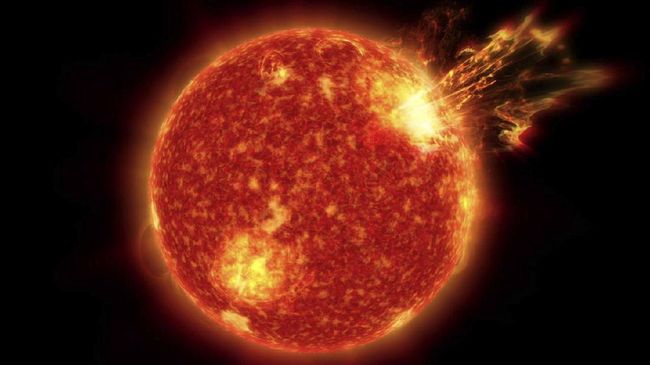CNN Indonesia
Monday, 01 Apr 2024 09:01 IWST
Illustration. The peak of the 25th solar cycle is predicted to occur this year earlier than predicted. (Photo: NASA)
Jakarta, CNN Indonesia —
For expert reveals the Sun will reach peak activity in Solar Cycle 25 (Solar Cycle 25) in 2024, one year earlier from previous estimates. The effect is positive for eclipse observers but negative for space workers.
The Space Weather Prediction Center (SWPC) at the US maritime and atmospheric agency (NOAA) said predictions of peak activity for Solar Cycle 25, known as ‘solar maximum’, were being revised and are expected to occur between January and October 2024.
“New Experimental Solar Cycle Predictions issued on October 25 [2023] concluded that solar activity would increase more rapidly and peak at a higher level than previously thought,” according to the agency’s statement.
“This latest prediction predicts Solar Cycle 25 will peak between January and October 2024, with a maximum number of sunspots between 137 and 173.”
Previously, a panel consisting of NOAA, the US space agency (NASA), and the International Space Environment Services (ISES), in 2019 estimated that Solar Cycle 25 would reach its peak in July 2025.
The maximum number of sunspots, commonly associated with solar storms, is predicted to reach 115, well below the average of 179.
The panel also predicted that Solar Cycle 25 would be as weak as Solar Cycle 24, which was the weakest cycle in the last 100 years with the number of sunspots at its peak reaching 116.
Even so, NOAA’s new predictions are still below average even though they are greater than the 2019 Panel predictions and greater than Solar Cycle 24.
Launch Space, The Solar Cycle describes a period of approximately 11 years of solar activity driven by the Sun’s magnetic field. This is indicated by the frequency and intensity of sunspots visible on the surface.
Predictions of when the Sun’s maximum will occur are based on long-term historical records of the number of Sunspots, advanced statistics, and models of the Solar dynamo (the flow of hot, ionized gas inside a star that produces the magnetic field that drives the Solar Cycle).
“We expect our new experimental estimates to be much more accurate than the panel’s 2019 predictions, and, unlike previous solar cycle predictions, these estimates will continue to be updated each month as new sunspot observations become available,” solar scientist Mark Miesch said in an institute statement.
“This is a pretty significant change.”
This revised prediction is good news for observers of celestial phenomena because the Total Solar Eclipse on April 8 will occur close to the maximum point of the Solar Cycle.
When the Moon covers the entire disk of the Sun during the total eclipse phase, the Sun’s outer atmosphere or corona is visible to observers.
During times of increased solar activity, the corona becomes very active and observers can potentially see a solar bulge in the form of a giant circle of plasma extending out from the Sun. It will look like a bright pink spot on the edge of the star.
Danger
Accurate predictions of solar activity are very important because geomagnetic storms triggered by plasma explosions or coronal mass ejections (CMEs) can affect power grids, GPS signals, drag satellites out of orbit.
In addition, there is a radiation risk for aviation workers and astronauts in space.
Early warning of space weather events can help industry implement safety procedures to reduce risks to their equipment and workers.
“We can’t ignore space weather, but we can take appropriate actions to protect ourselves,” NASA said.
The Earth does have natural protection, namely a magnetic field. When energetic particles and magnetic fields are released from the Sun during events such as solar flares and CMEs, the Earth is sometimes in the ‘line of fire’.
When this happens, Earth’s protective magnetic ‘bubble’, known as the magnetosphere, expels harmful energy from Earth and traps it in zones called the Van Allen radiation belts.
These donut-shaped radiation belts can swell when solar activity increases.
The problem is, Earth’s protective shield is by no means invincible.
During very strong space weather events, which occur more frequently during Solar Cycle maximums, the Earth’s magnetic field is disrupted and geomagnetic storms can penetrate the magnetosphere.
This caused widespread radio and power blackouts and endangered astronauts and satellites orbiting the Earth.
NASA an example is the case in 1989 when a CME was accompanied by a solar flare and caused all of Quebec, Canada, to experience a total blackout for 12 hours.
However, not all magnetospheric disturbances are destructive. This disturbance also causes an extraordinary sky show in the form of the aurora.
This phenomenon is known as the northern lights (aurora borealis) in the northern hemisphere and the southern lights (aurora australis) in the southern hemisphere. It is triggered by energetic particles being directed towards the Earth’s poles and colliding with oxygen and nitrogen atoms in the Earth’s atmosphere. .
(team/arh)
2024-04-01 02:01:50
#expert #warns #peak #solar #cycle #eclipse


